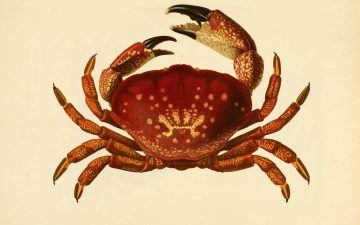Ellen Wayland-Smith in Aeon:
 Cancer has always been imagined as a biting, grasping, greedy beast. Hippocrates (or one of his students) is thought to be the first to name the disease karkinos, or crab, as ‘its veins are filled and stretched around like the feet of the animal called crab’. It was an image that would stick, embellished by physicians more deeply and vividly ever after. Like the crab, cancer was tenacious. ‘It is very hardly pulled away from those members, which it doth lay hold on, as the sea crab doth,’ remarked one 16th-century physician. There was no use in cutting away the tumour, just as there was no forcing a ‘Crab to quit what he has grasped betwixt his griping Claws,’ despaired another observer. Cancer the disease was as sneaky as its namesake. ‘It creeps little and little,’ noted one medieval commentator, ‘gnawing and fretting flesh and sinews slowish to the sight as it were a crab.’
Cancer has always been imagined as a biting, grasping, greedy beast. Hippocrates (or one of his students) is thought to be the first to name the disease karkinos, or crab, as ‘its veins are filled and stretched around like the feet of the animal called crab’. It was an image that would stick, embellished by physicians more deeply and vividly ever after. Like the crab, cancer was tenacious. ‘It is very hardly pulled away from those members, which it doth lay hold on, as the sea crab doth,’ remarked one 16th-century physician. There was no use in cutting away the tumour, just as there was no forcing a ‘Crab to quit what he has grasped betwixt his griping Claws,’ despaired another observer. Cancer the disease was as sneaky as its namesake. ‘It creeps little and little,’ noted one medieval commentator, ‘gnawing and fretting flesh and sinews slowish to the sight as it were a crab.’
Cancer’s gnawing behaviour led early physicians to compare it to a worm as well as to a crab. The medieval name for the plant-devouring green caterpillar, canker worm, derived from one such metaphorical leap from biology to botany: as cankers on the skin, so cankers in the bud. And just as malignant larvae in plants had to be destroyed before they blighted the flower, so one had to ‘sley the worm’ of cancer when it chanced to rear its head in human flesh. This worm could be quite literal; the 17th-century surgeon Pierre Dionis surmised that cancer was nothing more than a ‘prodigious Multitude of small worms’ infesting its host. A common medieval remedy, the so-called ‘meat cure’, involved laying slabs of fresh chicken or veal on the ulcer, by which to lure the creature out. Could the canker worm be convinced to ingest the decoy flesh, the patient might be spared.
More here.
